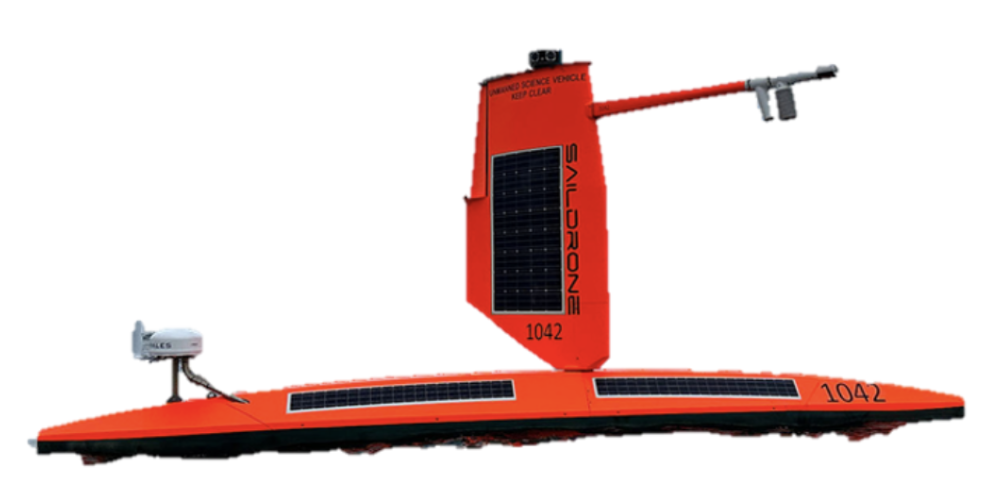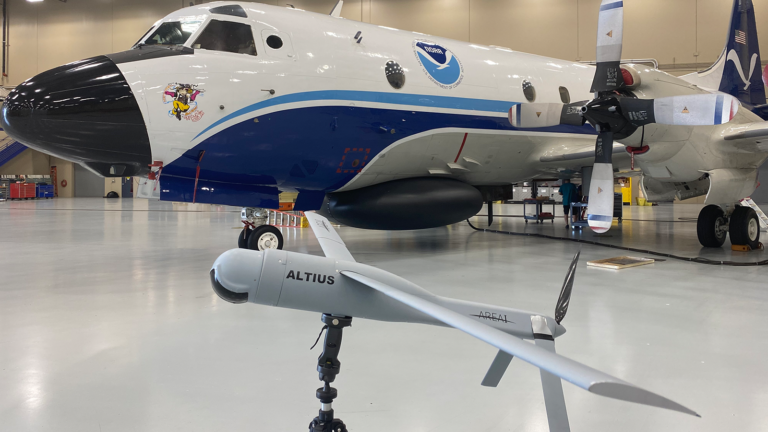NOAA has conducted a collocated drone mission into a hurricane, collecting data in the lower levels of the storm that have been historically too hard to reach – until now.
The NOAA Hurricane Field Program team flew several operational and research missions into Hurricane Tammy in October 2023 on board the NOAA Hurricane Hunter P-3 aircraft and collected data sets from multiple different instruments. In addition to the first ever Black Swift Technologies S0 drone launch into a storm, the research missions also resulted in the successful coordination of a low-flying drone (Anduril’s Altius 600), an ocean surface uncrewed vehicle from Saildrone, atmospheric profilers (dropsondes), and ocean profilers (bathythermographs).
Dozens of scientists, crew members and private industry partners planned and executed this choreography to gather hurricane data from satellites, at multiple levels of the atmosphere, down through the sea. By gathering data at different levels of the ocean and the atmosphere, NOAA continuously learns more about how storms form, build and intensify, with the ever-present goal of protecting lives and property.
Joe Cione, lead meteorologist for emerging technologies at NOAA, said, “Our team coordinated the Altius launch near a Saildrone, allowing both instruments to collect data that can be analyzed together and advance our knowledge of ocean-atmosphere interactions.”
 The Altius 600 is a small uncrewed aircraft system (sUAS) deployed from the NOAA Hurricane Hunter aircraft and capable of operating in low- and medium-altitude maritime environments. It collects data in the storm’s boundary layer that can better detect changes in the storm’s overall structure. Through Hurricane Tammy, it transmitted data from as low as 940ft above sea level.
The Altius 600 is a small uncrewed aircraft system (sUAS) deployed from the NOAA Hurricane Hunter aircraft and capable of operating in low- and medium-altitude maritime environments. It collects data in the storm’s boundary layer that can better detect changes in the storm’s overall structure. Through Hurricane Tammy, it transmitted data from as low as 940ft above sea level.
 A saildrone is a wind and solar-powered uncrewed surface vehicle (USV) that gathers data at and just below the ocean surface. These observations improve understanding and prediction of tropical cyclone intensity changes. The hurricane hunter aircraft flew over the saildrone three times during this mission, releasing additional instruments and collecting data from its onboard radar systems.
A saildrone is a wind and solar-powered uncrewed surface vehicle (USV) that gathers data at and just below the ocean surface. These observations improve understanding and prediction of tropical cyclone intensity changes. The hurricane hunter aircraft flew over the saildrone three times during this mission, releasing additional instruments and collecting data from its onboard radar systems.
Greg Foltz, AOML oceanographer at NOAA and one of the principal investigators of the Saildrone project, commented, “Before NOAA’s partnership with Saildrone, there weren’t any instruments that could measure the exchange of heat and momentum between the ocean and hurricanes, which could also be steered into the path of a hurricane.”
Airborne EXpendable BathyThermographs (AXBTs) are small probes released from aircraft that measure ocean temperature as a function of depth as they descend through the water column. They were also launched near the saildrone and collected ocean temperature data down to a depth of 350m.
Dropsondes are small instruments that collect profiles of atmospheric pressure, temperature, relative humidity, wind speed and wind direction as they descend through the atmosphere. Several were launched from the aircraft in the area immediately around the saildrone and near the Altius (as close as 1.4 nautical miles from a saildrone). A special dropsonde outfitted with a downward-looking infrared sensor was also capable of measuring sea surface temperature (SST).
These measurements will be compared and validated with SSTs measured by both the saildrone, the Altius 600 and the Airborne EXpendable BathyThermograph that was also deployed from NOAA’s P-3 Hurricane Hunter aircraft.
Simultaneously, the P-3 aircraft flew through the storm, gathering data from the fully operational Tail Doppler Radar, which pinpoints where the strongest winds are located, how far they extend outward from a storm’s center and the regions of heaviest rainfall, giving a three-dimensional view from just above the ocean surface to the very top of the storm.
By collecting observational data in so many different areas of the storm, scientists and forecasters could learn about the formation, development, track and intensification of tropical cyclones. The more known about these storms, the better equipped we are to predict phenomena like rapid intensification – when the winds of a tropical cyclone increase by 35mph or more within 24 hours. Rapid intensification is hard to predict so this coordinated mission is a step in the right direction to improving future hurricane predictions.
Watch live footage from NOAA’s storm drone, here.



